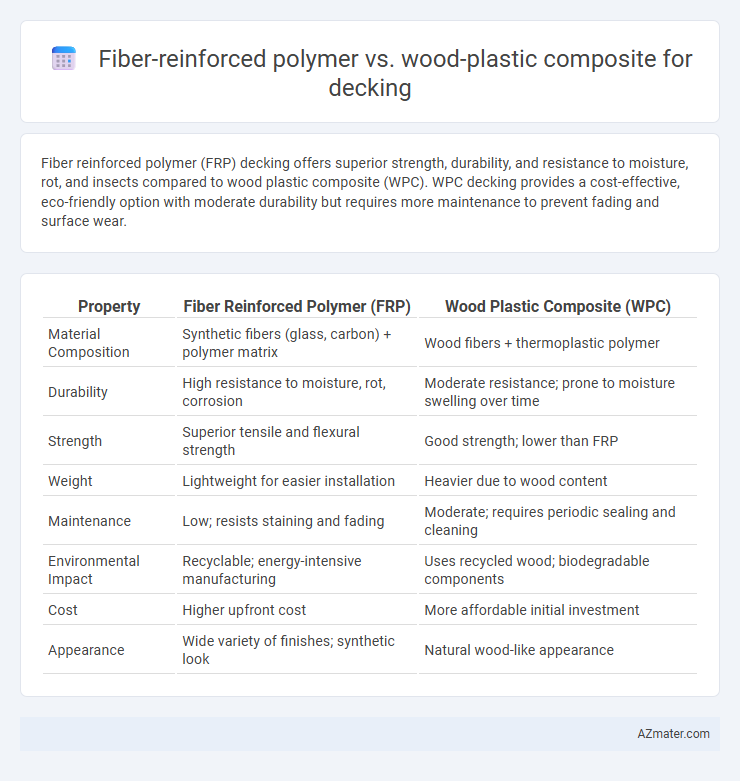Fiber reinforced polymer (FRP) decking offers superior strength, durability, and resistance to moisture, rot, and insects compared to wood plastic composite (WPC). WPC decking provides a cost-effective, eco-friendly option with moderate durability but requires more maintenance to prevent fading and surface wear.
Table of Comparison
| Property | Fiber Reinforced Polymer (FRP) | Wood Plastic Composite (WPC) |
|---|---|---|
| Material Composition | Synthetic fibers (glass, carbon) + polymer matrix | Wood fibers + thermoplastic polymer |
| Durability | High resistance to moisture, rot, corrosion | Moderate resistance; prone to moisture swelling over time |
| Strength | Superior tensile and flexural strength | Good strength; lower than FRP |
| Weight | Lightweight for easier installation | Heavier due to wood content |
| Maintenance | Low; resists staining and fading | Moderate; requires periodic sealing and cleaning |
| Environmental Impact | Recyclable; energy-intensive manufacturing | Uses recycled wood; biodegradable components |
| Cost | Higher upfront cost | More affordable initial investment |
| Appearance | Wide variety of finishes; synthetic look | Natural wood-like appearance |
Introduction to Decking Materials
Fiber reinforced polymer (FRP) decking offers superior strength-to-weight ratio, high resistance to moisture, rot, and insect damage, making it ideal for long-lasting outdoor applications. Wood plastic composite (WPC) decking combines wood fibers with thermoplastics, providing a natural wood appearance with enhanced durability and low maintenance requirements. Both materials significantly outperform traditional wood in terms of longevity, weather resistance, and environmental sustainability for decking solutions.
Overview of Fiber Reinforced Polymer (FRP) Decking
Fiber Reinforced Polymer (FRP) decking combines high-strength fibers such as glass or carbon with polymer matrices, offering exceptional durability and resistance to moisture, rot, and insects. FRP decking typically exhibits superior load-bearing capacity and long-term structural integrity compared to Wood Plastic Composite (WPC), making it ideal for harsh environments and heavy foot traffic. Its low maintenance requirements and resistance to warping or splintering further enhance its appeal for commercial and residential outdoor applications.
Understanding Wood Plastic Composite (WPC) Decking
Wood Plastic Composite (WPC) decking combines wood fibers and thermoplastics, creating a durable, low-maintenance material resistant to rot, insects, and moisture. Its enhanced weather resistance and smooth finish make it popular for outdoor applications compared to traditional wood. WPC decking offers sustainable benefits by utilizing recycled materials and reduces the environmental impact often associated with virgin wood harvesting.
Material Composition and Structure Comparison
Fiber reinforced polymer (FRP) decking typically consists of high-strength synthetic fibers such as glass or carbon embedded in a polymer matrix, offering superior tensile strength, durability, and resistance to moisture and UV exposure compared to wood plastic composite (WPC), which combines wood fibers or flour with thermoplastic resins like polyethylene or polypropylene. The FRP's homogeneous, engineered structure provides consistent performance and minimal maintenance, while WPC's heterogeneous blend retains some natural wood characteristics but is more susceptible to swelling, staining, and degradation over time. Material composition in FRP allows for tailored mechanical properties and long-term stability, contrasting with WPC's cost-effective nature that sacrifices some structural integrity and weather resistance.
Durability and Weather Resistance
Fiber reinforced polymer (FRP) decking exhibits superior durability and weather resistance compared to wood plastic composite (WPC). FRP's high tensile strength and resistance to moisture, UV rays, and temperature fluctuations prevent warping, splintering, and rot over time. WPC, while more resistant to decay than natural wood, tends to absorb moisture and is prone to fading and surface degradation under prolonged exposure to harsh weather conditions.
Maintenance Requirements for FRP and WPC
Fiber reinforced polymer (FRP) decking requires minimal maintenance due to its high resistance to moisture, rot, and insect damage, eliminating the need for regular sealing or staining. Wood plastic composite (WPC) decking, while more resistant to decay than traditional wood, still demands periodic cleaning and occasional sealing to prevent surface mold and discoloration. FRP's non-porous surface ensures longevity with less upkeep, making it a more durable choice for low-maintenance decking solutions.
Aesthetics and Design Flexibility
Fiber reinforced polymer (FRP) decking offers superior aesthetics with a sleek, modern appearance and a high degree of customization in color, texture, and finish, allowing for seamless design integration. Wood plastic composite (WPC) decking provides a natural wood-like look with warm, earthy tones but less variation in texture and fewer options for customization compared to FRP. Design flexibility in FRP extends to complex shapes and structural applications due to its strength-to-weight ratio, whereas WPC is generally limited to standard plank shapes and sizes.
Environmental Impact and Sustainability
Fiber reinforced polymer (FRP) decking generally offers superior durability and requires less maintenance than wood plastic composite (WPC), reducing material waste and extending product lifespan. WPC, often made from recycled plastics and wood fibers, contributes to waste reduction but can face challenges in biodegradability and chemical additives affecting soil health. Evaluating environmental impact, FRP's longer lifecycle and lower replacement frequency enhance sustainability, while WPC's use of recycled content supports circular economy principles in decking materials.
Cost Analysis and Long-Term Value
Fiber reinforced polymer (FRP) decking generally has a higher upfront cost than wood plastic composite (WPC) due to its superior strength and durability. Over time, FRP requires less maintenance and resists rot, moisture, and insect damage better than WPC, which can lead to lower lifecycle costs despite the initial investment. The long-term value of FRP decking is enhanced by its extended lifespan and reduced need for repairs, making it more cost-effective for projects prioritizing durability and minimal upkeep.
Choosing the Right Decking Material for Your Project
Fiber reinforced polymer (FRP) decking offers superior durability, moisture resistance, and low maintenance compared to wood plastic composite (WPC), making it ideal for high-traffic or harsh weather environments. Wood plastic composite provides a more natural wood appearance with moderate durability, often preferred for aesthetic appeal and budget-friendly projects. Selecting the right decking material depends on factors like environmental exposure, desired lifespan, maintenance tolerance, and project budget.

Infographic: Fiber reinforced polymer vs Wood plastic composite for Decking
 azmater.com
azmater.com